Financial Reporting: Conceptual Framework
VerifiedAdded on 2021/02/21
|17
|4672
|56
AI Summary
Contribute Materials
Your contribution can guide someone’s learning journey. Share your
documents today.
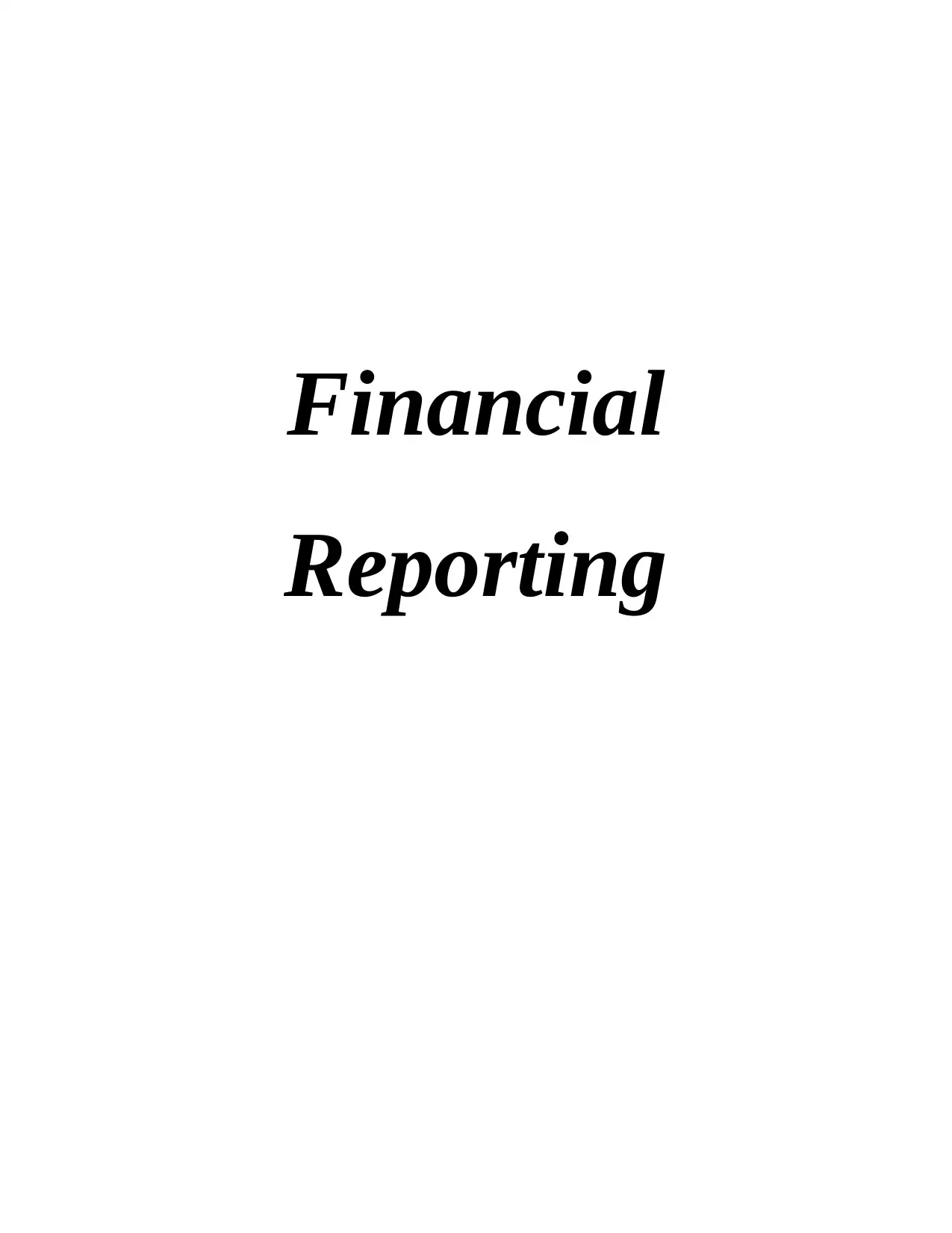
Financial
Reporting
Reporting
Secure Best Marks with AI Grader
Need help grading? Try our AI Grader for instant feedback on your assignments.
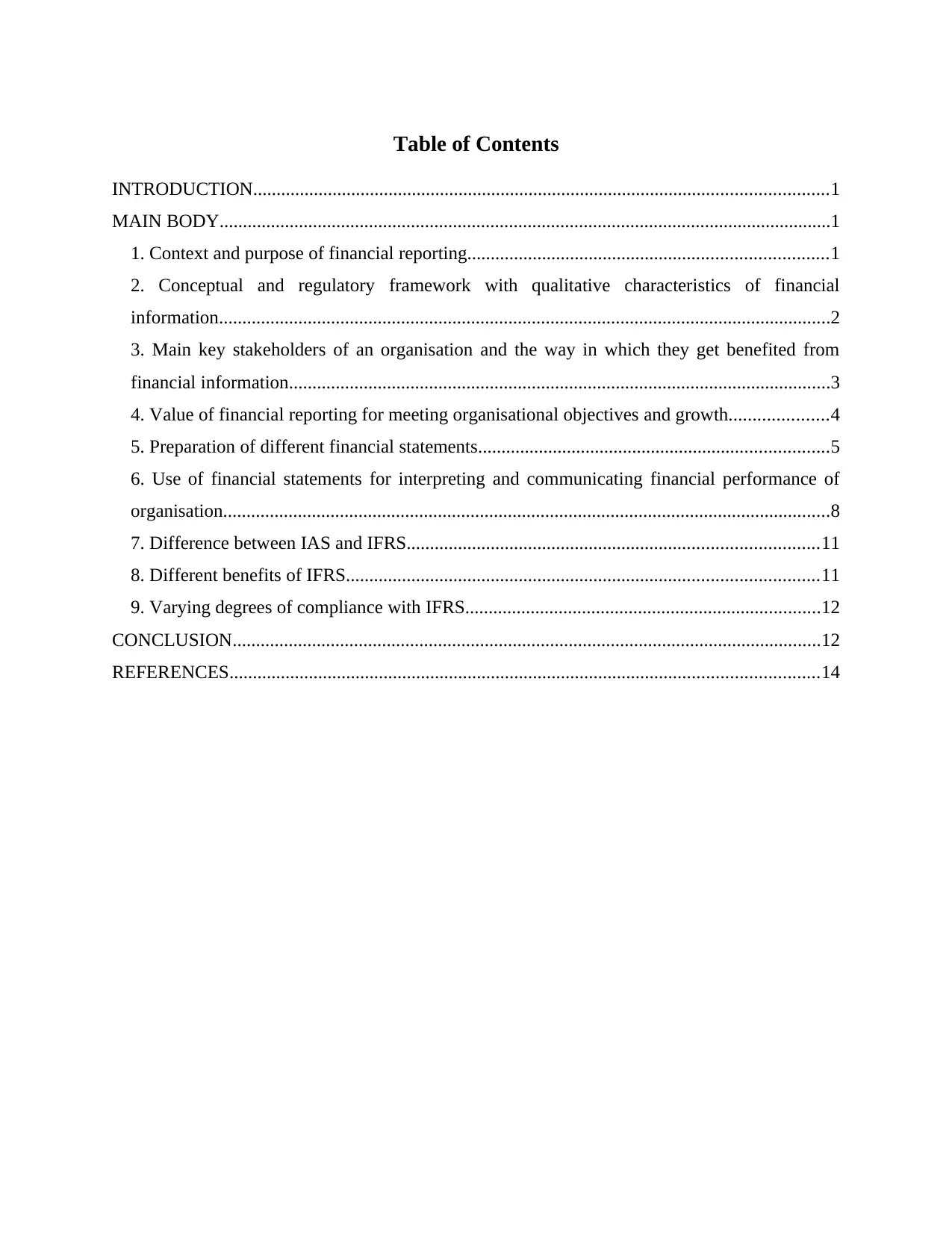
Table of Contents
INTRODUCTION...........................................................................................................................1
MAIN BODY...................................................................................................................................1
1. Context and purpose of financial reporting.............................................................................1
2. Conceptual and regulatory framework with qualitative characteristics of financial
information...................................................................................................................................2
3. Main key stakeholders of an organisation and the way in which they get benefited from
financial information....................................................................................................................3
4. Value of financial reporting for meeting organisational objectives and growth.....................4
5. Preparation of different financial statements...........................................................................5
6. Use of financial statements for interpreting and communicating financial performance of
organisation..................................................................................................................................8
7. Difference between IAS and IFRS........................................................................................11
8. Different benefits of IFRS.....................................................................................................11
9. Varying degrees of compliance with IFRS............................................................................12
CONCLUSION..............................................................................................................................12
REFERENCES..............................................................................................................................14
INTRODUCTION...........................................................................................................................1
MAIN BODY...................................................................................................................................1
1. Context and purpose of financial reporting.............................................................................1
2. Conceptual and regulatory framework with qualitative characteristics of financial
information...................................................................................................................................2
3. Main key stakeholders of an organisation and the way in which they get benefited from
financial information....................................................................................................................3
4. Value of financial reporting for meeting organisational objectives and growth.....................4
5. Preparation of different financial statements...........................................................................5
6. Use of financial statements for interpreting and communicating financial performance of
organisation..................................................................................................................................8
7. Difference between IAS and IFRS........................................................................................11
8. Different benefits of IFRS.....................................................................................................11
9. Varying degrees of compliance with IFRS............................................................................12
CONCLUSION..............................................................................................................................12
REFERENCES..............................................................................................................................14
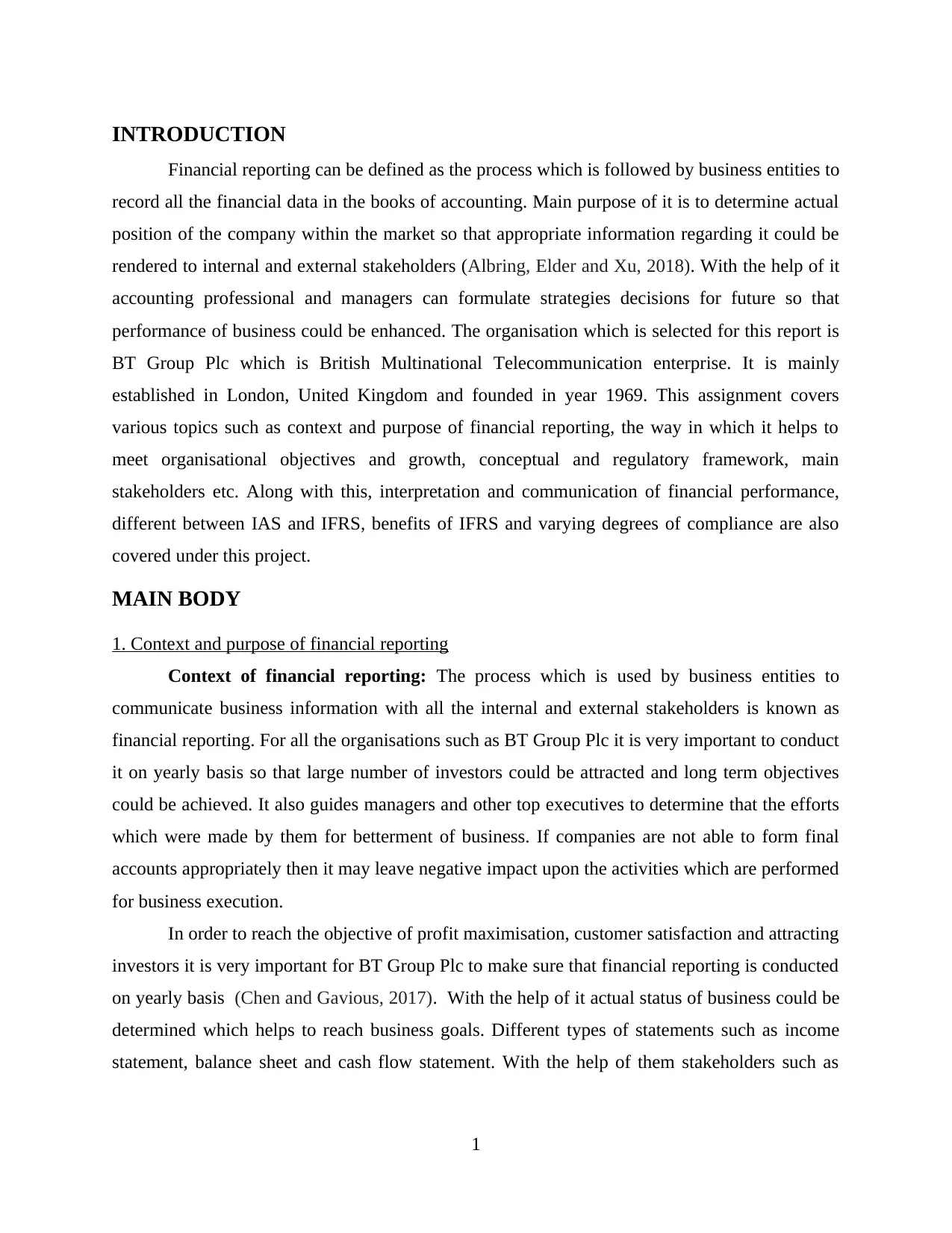
INTRODUCTION
Financial reporting can be defined as the process which is followed by business entities to
record all the financial data in the books of accounting. Main purpose of it is to determine actual
position of the company within the market so that appropriate information regarding it could be
rendered to internal and external stakeholders (Albring, Elder and Xu, 2018). With the help of it
accounting professional and managers can formulate strategies decisions for future so that
performance of business could be enhanced. The organisation which is selected for this report is
BT Group Plc which is British Multinational Telecommunication enterprise. It is mainly
established in London, United Kingdom and founded in year 1969. This assignment covers
various topics such as context and purpose of financial reporting, the way in which it helps to
meet organisational objectives and growth, conceptual and regulatory framework, main
stakeholders etc. Along with this, interpretation and communication of financial performance,
different between IAS and IFRS, benefits of IFRS and varying degrees of compliance are also
covered under this project.
MAIN BODY
1. Context and purpose of financial reporting
Context of financial reporting: The process which is used by business entities to
communicate business information with all the internal and external stakeholders is known as
financial reporting. For all the organisations such as BT Group Plc it is very important to conduct
it on yearly basis so that large number of investors could be attracted and long term objectives
could be achieved. It also guides managers and other top executives to determine that the efforts
which were made by them for betterment of business. If companies are not able to form final
accounts appropriately then it may leave negative impact upon the activities which are performed
for business execution.
In order to reach the objective of profit maximisation, customer satisfaction and attracting
investors it is very important for BT Group Plc to make sure that financial reporting is conducted
on yearly basis (Chen and Gavious, 2017). With the help of it actual status of business could be
determined which helps to reach business goals. Different types of statements such as income
statement, balance sheet and cash flow statement. With the help of them stakeholders such as
1
Financial reporting can be defined as the process which is followed by business entities to
record all the financial data in the books of accounting. Main purpose of it is to determine actual
position of the company within the market so that appropriate information regarding it could be
rendered to internal and external stakeholders (Albring, Elder and Xu, 2018). With the help of it
accounting professional and managers can formulate strategies decisions for future so that
performance of business could be enhanced. The organisation which is selected for this report is
BT Group Plc which is British Multinational Telecommunication enterprise. It is mainly
established in London, United Kingdom and founded in year 1969. This assignment covers
various topics such as context and purpose of financial reporting, the way in which it helps to
meet organisational objectives and growth, conceptual and regulatory framework, main
stakeholders etc. Along with this, interpretation and communication of financial performance,
different between IAS and IFRS, benefits of IFRS and varying degrees of compliance are also
covered under this project.
MAIN BODY
1. Context and purpose of financial reporting
Context of financial reporting: The process which is used by business entities to
communicate business information with all the internal and external stakeholders is known as
financial reporting. For all the organisations such as BT Group Plc it is very important to conduct
it on yearly basis so that large number of investors could be attracted and long term objectives
could be achieved. It also guides managers and other top executives to determine that the efforts
which were made by them for betterment of business. If companies are not able to form final
accounts appropriately then it may leave negative impact upon the activities which are performed
for business execution.
In order to reach the objective of profit maximisation, customer satisfaction and attracting
investors it is very important for BT Group Plc to make sure that financial reporting is conducted
on yearly basis (Chen and Gavious, 2017). With the help of it actual status of business could be
determined which helps to reach business goals. Different types of statements such as income
statement, balance sheet and cash flow statement. With the help of them stakeholders such as
1
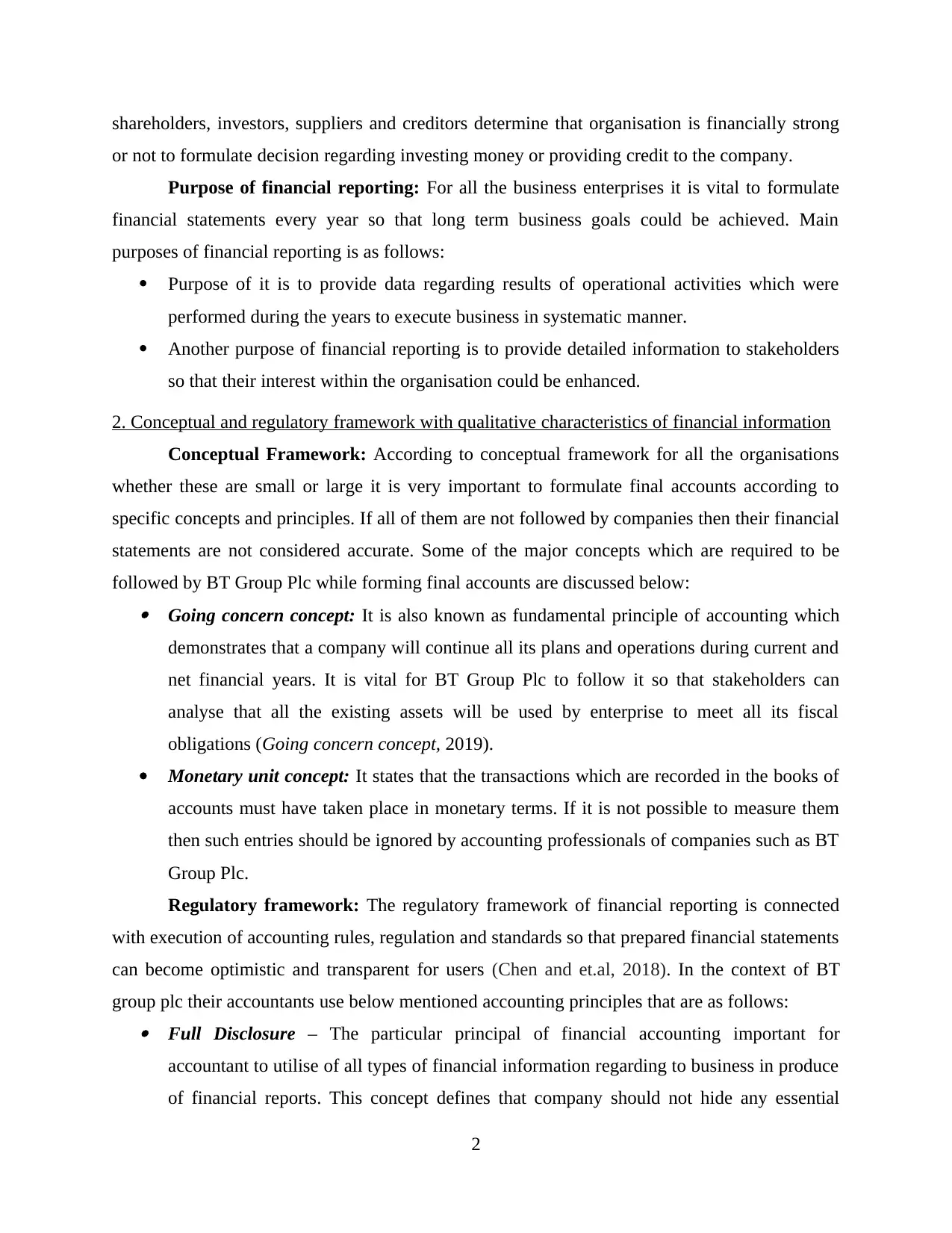
shareholders, investors, suppliers and creditors determine that organisation is financially strong
or not to formulate decision regarding investing money or providing credit to the company.
Purpose of financial reporting: For all the business enterprises it is vital to formulate
financial statements every year so that long term business goals could be achieved. Main
purposes of financial reporting is as follows:
Purpose of it is to provide data regarding results of operational activities which were
performed during the years to execute business in systematic manner.
Another purpose of financial reporting is to provide detailed information to stakeholders
so that their interest within the organisation could be enhanced.
2. Conceptual and regulatory framework with qualitative characteristics of financial information
Conceptual Framework: According to conceptual framework for all the organisations
whether these are small or large it is very important to formulate final accounts according to
specific concepts and principles. If all of them are not followed by companies then their financial
statements are not considered accurate. Some of the major concepts which are required to be
followed by BT Group Plc while forming final accounts are discussed below: Going concern concept: It is also known as fundamental principle of accounting which
demonstrates that a company will continue all its plans and operations during current and
net financial years. It is vital for BT Group Plc to follow it so that stakeholders can
analyse that all the existing assets will be used by enterprise to meet all its fiscal
obligations (Going concern concept, 2019).
Monetary unit concept: It states that the transactions which are recorded in the books of
accounts must have taken place in monetary terms. If it is not possible to measure them
then such entries should be ignored by accounting professionals of companies such as BT
Group Plc.
Regulatory framework: The regulatory framework of financial reporting is connected
with execution of accounting rules, regulation and standards so that prepared financial statements
can become optimistic and transparent for users (Chen and et.al, 2018). In the context of BT
group plc their accountants use below mentioned accounting principles that are as follows: Full Disclosure – The particular principal of financial accounting important for
accountant to utilise of all types of financial information regarding to business in produce
of financial reports. This concept defines that company should not hide any essential
2
or not to formulate decision regarding investing money or providing credit to the company.
Purpose of financial reporting: For all the business enterprises it is vital to formulate
financial statements every year so that long term business goals could be achieved. Main
purposes of financial reporting is as follows:
Purpose of it is to provide data regarding results of operational activities which were
performed during the years to execute business in systematic manner.
Another purpose of financial reporting is to provide detailed information to stakeholders
so that their interest within the organisation could be enhanced.
2. Conceptual and regulatory framework with qualitative characteristics of financial information
Conceptual Framework: According to conceptual framework for all the organisations
whether these are small or large it is very important to formulate final accounts according to
specific concepts and principles. If all of them are not followed by companies then their financial
statements are not considered accurate. Some of the major concepts which are required to be
followed by BT Group Plc while forming final accounts are discussed below: Going concern concept: It is also known as fundamental principle of accounting which
demonstrates that a company will continue all its plans and operations during current and
net financial years. It is vital for BT Group Plc to follow it so that stakeholders can
analyse that all the existing assets will be used by enterprise to meet all its fiscal
obligations (Going concern concept, 2019).
Monetary unit concept: It states that the transactions which are recorded in the books of
accounts must have taken place in monetary terms. If it is not possible to measure them
then such entries should be ignored by accounting professionals of companies such as BT
Group Plc.
Regulatory framework: The regulatory framework of financial reporting is connected
with execution of accounting rules, regulation and standards so that prepared financial statements
can become optimistic and transparent for users (Chen and et.al, 2018). In the context of BT
group plc their accountants use below mentioned accounting principles that are as follows: Full Disclosure – The particular principal of financial accounting important for
accountant to utilise of all types of financial information regarding to business in produce
of financial reports. This concept defines that company should not hide any essential
2
Secure Best Marks with AI Grader
Need help grading? Try our AI Grader for instant feedback on your assignments.
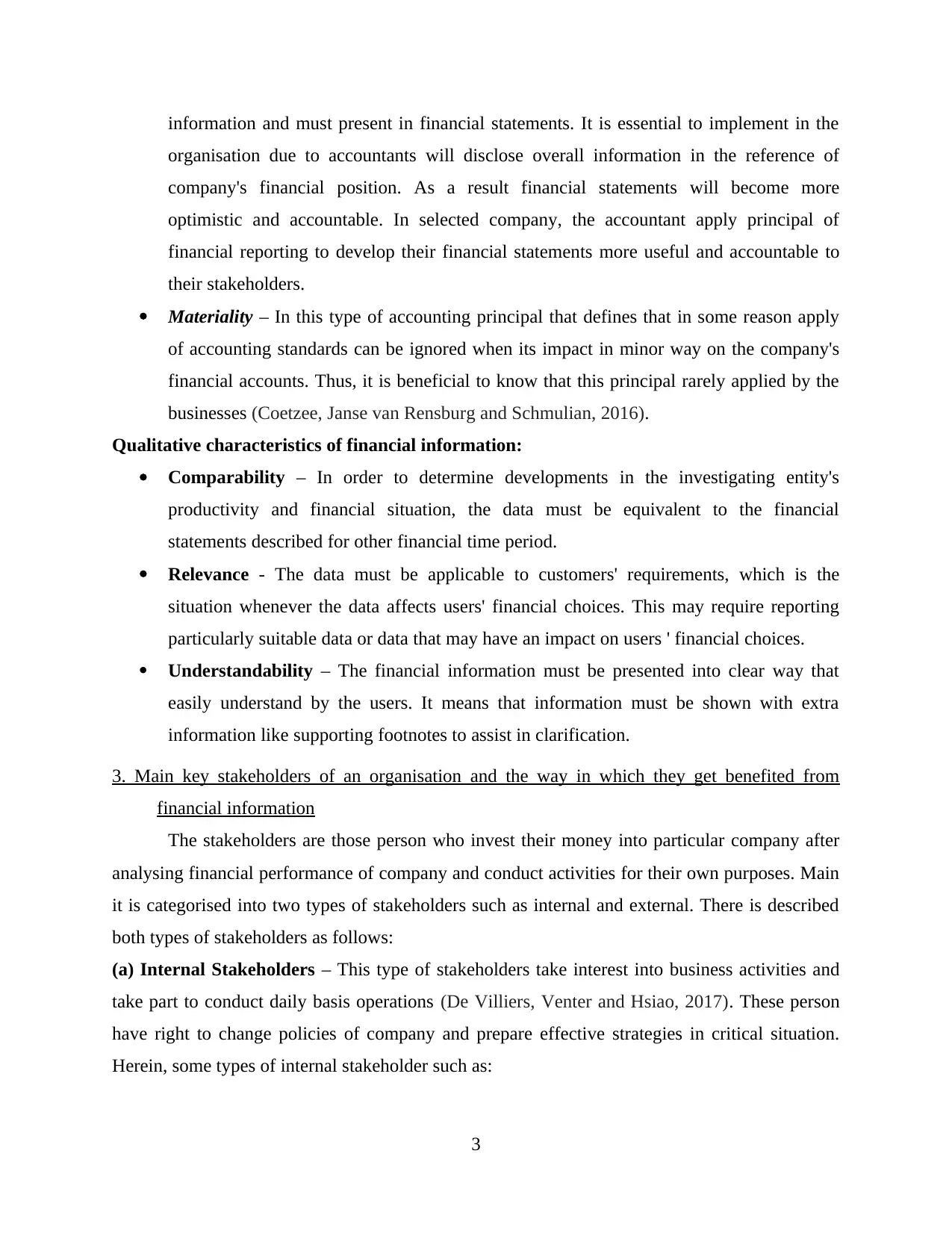
information and must present in financial statements. It is essential to implement in the
organisation due to accountants will disclose overall information in the reference of
company's financial position. As a result financial statements will become more
optimistic and accountable. In selected company, the accountant apply principal of
financial reporting to develop their financial statements more useful and accountable to
their stakeholders.
Materiality – In this type of accounting principal that defines that in some reason apply
of accounting standards can be ignored when its impact in minor way on the company's
financial accounts. Thus, it is beneficial to know that this principal rarely applied by the
businesses (Coetzee, Janse van Rensburg and Schmulian, 2016).
Qualitative characteristics of financial information:
Comparability – In order to determine developments in the investigating entity's
productivity and financial situation, the data must be equivalent to the financial
statements described for other financial time period.
Relevance - The data must be applicable to customers' requirements, which is the
situation whenever the data affects users' financial choices. This may require reporting
particularly suitable data or data that may have an impact on users ' financial choices.
Understandability – The financial information must be presented into clear way that
easily understand by the users. It means that information must be shown with extra
information like supporting footnotes to assist in clarification.
3. Main key stakeholders of an organisation and the way in which they get benefited from
financial information
The stakeholders are those person who invest their money into particular company after
analysing financial performance of company and conduct activities for their own purposes. Main
it is categorised into two types of stakeholders such as internal and external. There is described
both types of stakeholders as follows:
(a) Internal Stakeholders – This type of stakeholders take interest into business activities and
take part to conduct daily basis operations (De Villiers, Venter and Hsiao, 2017). These person
have right to change policies of company and prepare effective strategies in critical situation.
Herein, some types of internal stakeholder such as:
3
organisation due to accountants will disclose overall information in the reference of
company's financial position. As a result financial statements will become more
optimistic and accountable. In selected company, the accountant apply principal of
financial reporting to develop their financial statements more useful and accountable to
their stakeholders.
Materiality – In this type of accounting principal that defines that in some reason apply
of accounting standards can be ignored when its impact in minor way on the company's
financial accounts. Thus, it is beneficial to know that this principal rarely applied by the
businesses (Coetzee, Janse van Rensburg and Schmulian, 2016).
Qualitative characteristics of financial information:
Comparability – In order to determine developments in the investigating entity's
productivity and financial situation, the data must be equivalent to the financial
statements described for other financial time period.
Relevance - The data must be applicable to customers' requirements, which is the
situation whenever the data affects users' financial choices. This may require reporting
particularly suitable data or data that may have an impact on users ' financial choices.
Understandability – The financial information must be presented into clear way that
easily understand by the users. It means that information must be shown with extra
information like supporting footnotes to assist in clarification.
3. Main key stakeholders of an organisation and the way in which they get benefited from
financial information
The stakeholders are those person who invest their money into particular company after
analysing financial performance of company and conduct activities for their own purposes. Main
it is categorised into two types of stakeholders such as internal and external. There is described
both types of stakeholders as follows:
(a) Internal Stakeholders – This type of stakeholders take interest into business activities and
take part to conduct daily basis operations (De Villiers, Venter and Hsiao, 2017). These person
have right to change policies of company and prepare effective strategies in critical situation.
Herein, some types of internal stakeholder such as:
3
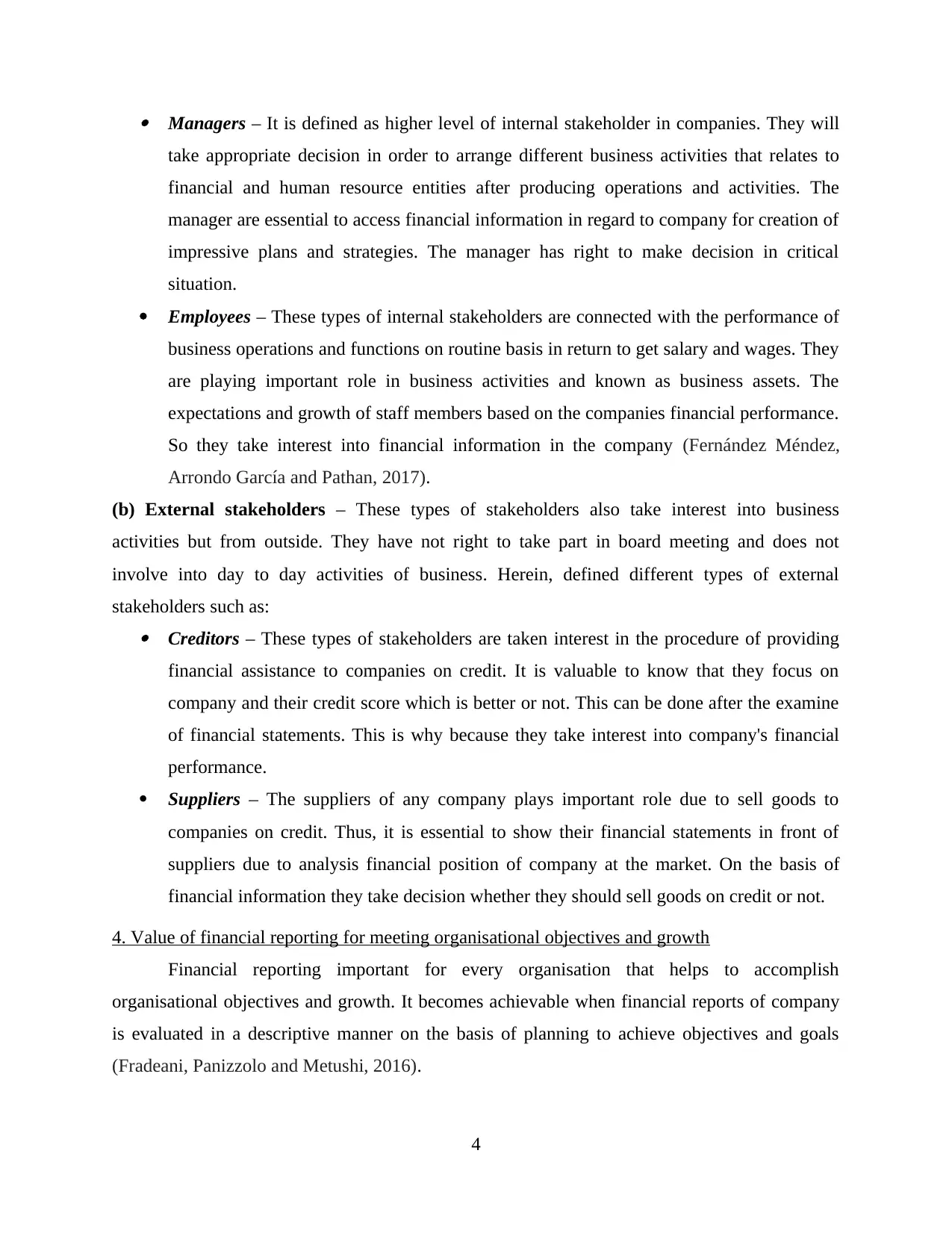
Managers – It is defined as higher level of internal stakeholder in companies. They will
take appropriate decision in order to arrange different business activities that relates to
financial and human resource entities after producing operations and activities. The
manager are essential to access financial information in regard to company for creation of
impressive plans and strategies. The manager has right to make decision in critical
situation.
Employees – These types of internal stakeholders are connected with the performance of
business operations and functions on routine basis in return to get salary and wages. They
are playing important role in business activities and known as business assets. The
expectations and growth of staff members based on the companies financial performance.
So they take interest into financial information in the company (Fernández Méndez,
Arrondo García and Pathan, 2017).
(b) External stakeholders – These types of stakeholders also take interest into business
activities but from outside. They have not right to take part in board meeting and does not
involve into day to day activities of business. Herein, defined different types of external
stakeholders such as: Creditors – These types of stakeholders are taken interest in the procedure of providing
financial assistance to companies on credit. It is valuable to know that they focus on
company and their credit score which is better or not. This can be done after the examine
of financial statements. This is why because they take interest into company's financial
performance.
Suppliers – The suppliers of any company plays important role due to sell goods to
companies on credit. Thus, it is essential to show their financial statements in front of
suppliers due to analysis financial position of company at the market. On the basis of
financial information they take decision whether they should sell goods on credit or not.
4. Value of financial reporting for meeting organisational objectives and growth
Financial reporting important for every organisation that helps to accomplish
organisational objectives and growth. It becomes achievable when financial reports of company
is evaluated in a descriptive manner on the basis of planning to achieve objectives and goals
(Fradeani, Panizzolo and Metushi, 2016).
4
take appropriate decision in order to arrange different business activities that relates to
financial and human resource entities after producing operations and activities. The
manager are essential to access financial information in regard to company for creation of
impressive plans and strategies. The manager has right to make decision in critical
situation.
Employees – These types of internal stakeholders are connected with the performance of
business operations and functions on routine basis in return to get salary and wages. They
are playing important role in business activities and known as business assets. The
expectations and growth of staff members based on the companies financial performance.
So they take interest into financial information in the company (Fernández Méndez,
Arrondo García and Pathan, 2017).
(b) External stakeholders – These types of stakeholders also take interest into business
activities but from outside. They have not right to take part in board meeting and does not
involve into day to day activities of business. Herein, defined different types of external
stakeholders such as: Creditors – These types of stakeholders are taken interest in the procedure of providing
financial assistance to companies on credit. It is valuable to know that they focus on
company and their credit score which is better or not. This can be done after the examine
of financial statements. This is why because they take interest into company's financial
performance.
Suppliers – The suppliers of any company plays important role due to sell goods to
companies on credit. Thus, it is essential to show their financial statements in front of
suppliers due to analysis financial position of company at the market. On the basis of
financial information they take decision whether they should sell goods on credit or not.
4. Value of financial reporting for meeting organisational objectives and growth
Financial reporting important for every organisation that helps to accomplish
organisational objectives and growth. It becomes achievable when financial reports of company
is evaluated in a descriptive manner on the basis of planning to achieve objectives and goals
(Fradeani, Panizzolo and Metushi, 2016).
4
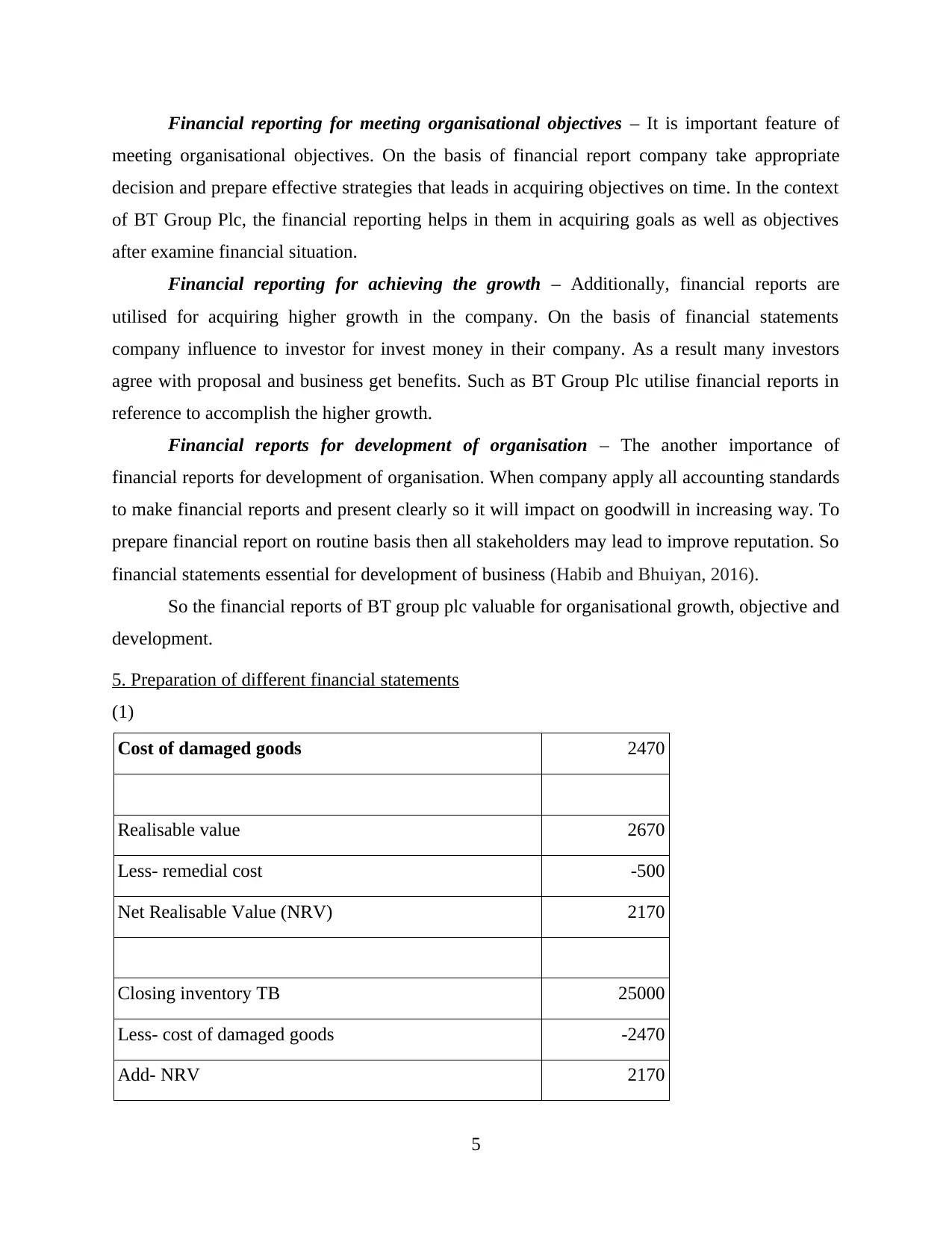
Financial reporting for meeting organisational objectives – It is important feature of
meeting organisational objectives. On the basis of financial report company take appropriate
decision and prepare effective strategies that leads in acquiring objectives on time. In the context
of BT Group Plc, the financial reporting helps in them in acquiring goals as well as objectives
after examine financial situation.
Financial reporting for achieving the growth – Additionally, financial reports are
utilised for acquiring higher growth in the company. On the basis of financial statements
company influence to investor for invest money in their company. As a result many investors
agree with proposal and business get benefits. Such as BT Group Plc utilise financial reports in
reference to accomplish the higher growth.
Financial reports for development of organisation – The another importance of
financial reports for development of organisation. When company apply all accounting standards
to make financial reports and present clearly so it will impact on goodwill in increasing way. To
prepare financial report on routine basis then all stakeholders may lead to improve reputation. So
financial statements essential for development of business (Habib and Bhuiyan, 2016).
So the financial reports of BT group plc valuable for organisational growth, objective and
development.
5. Preparation of different financial statements
(1)
Cost of damaged goods 2470
Realisable value 2670
Less- remedial cost -500
Net Realisable Value (NRV) 2170
Closing inventory TB 25000
Less- cost of damaged goods -2470
Add- NRV 2170
5
meeting organisational objectives. On the basis of financial report company take appropriate
decision and prepare effective strategies that leads in acquiring objectives on time. In the context
of BT Group Plc, the financial reporting helps in them in acquiring goals as well as objectives
after examine financial situation.
Financial reporting for achieving the growth – Additionally, financial reports are
utilised for acquiring higher growth in the company. On the basis of financial statements
company influence to investor for invest money in their company. As a result many investors
agree with proposal and business get benefits. Such as BT Group Plc utilise financial reports in
reference to accomplish the higher growth.
Financial reports for development of organisation – The another importance of
financial reports for development of organisation. When company apply all accounting standards
to make financial reports and present clearly so it will impact on goodwill in increasing way. To
prepare financial report on routine basis then all stakeholders may lead to improve reputation. So
financial statements essential for development of business (Habib and Bhuiyan, 2016).
So the financial reports of BT group plc valuable for organisational growth, objective and
development.
5. Preparation of different financial statements
(1)
Cost of damaged goods 2470
Realisable value 2670
Less- remedial cost -500
Net Realisable Value (NRV) 2170
Closing inventory TB 25000
Less- cost of damaged goods -2470
Add- NRV 2170
5
Paraphrase This Document
Need a fresh take? Get an instant paraphrase of this document with our AI Paraphraser
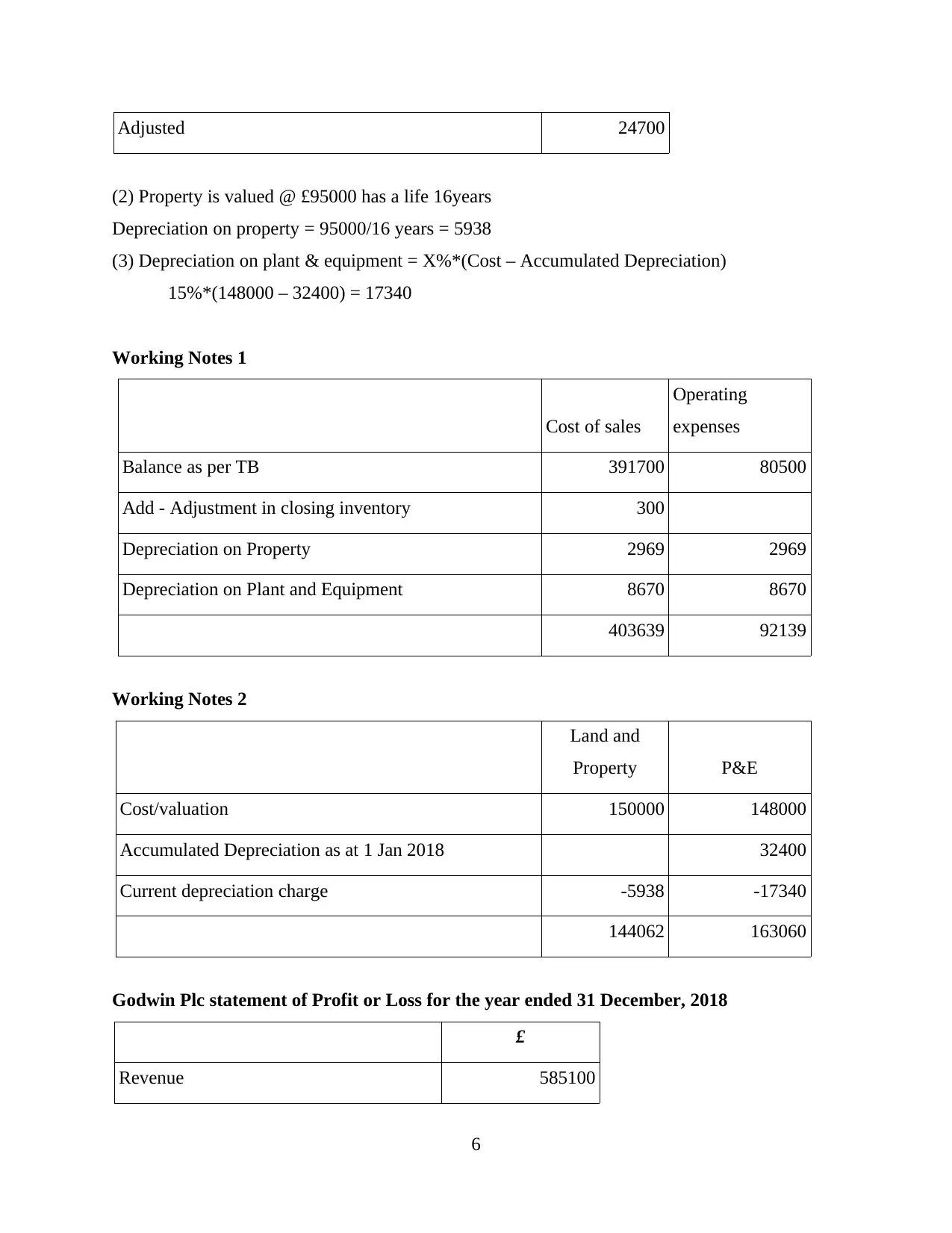
Adjusted 24700
(2) Property is valued @ £95000 has a life 16years
Depreciation on property = 95000/16 years = 5938
(3) Depreciation on plant & equipment = X%*(Cost – Accumulated Depreciation)
15%*(148000 – 32400) = 17340
Working Notes 1
Cost of sales
Operating
expenses
Balance as per TB 391700 80500
Add - Adjustment in closing inventory 300
Depreciation on Property 2969 2969
Depreciation on Plant and Equipment 8670 8670
403639 92139
Working Notes 2
Land and
Property P&E
Cost/valuation 150000 148000
Accumulated Depreciation as at 1 Jan 2018 32400
Current depreciation charge -5938 -17340
144062 163060
Godwin Plc statement of Profit or Loss for the year ended 31 December, 2018
£
Revenue 585100
6
(2) Property is valued @ £95000 has a life 16years
Depreciation on property = 95000/16 years = 5938
(3) Depreciation on plant & equipment = X%*(Cost – Accumulated Depreciation)
15%*(148000 – 32400) = 17340
Working Notes 1
Cost of sales
Operating
expenses
Balance as per TB 391700 80500
Add - Adjustment in closing inventory 300
Depreciation on Property 2969 2969
Depreciation on Plant and Equipment 8670 8670
403639 92139
Working Notes 2
Land and
Property P&E
Cost/valuation 150000 148000
Accumulated Depreciation as at 1 Jan 2018 32400
Current depreciation charge -5938 -17340
144062 163060
Godwin Plc statement of Profit or Loss for the year ended 31 December, 2018
£
Revenue 585100
6
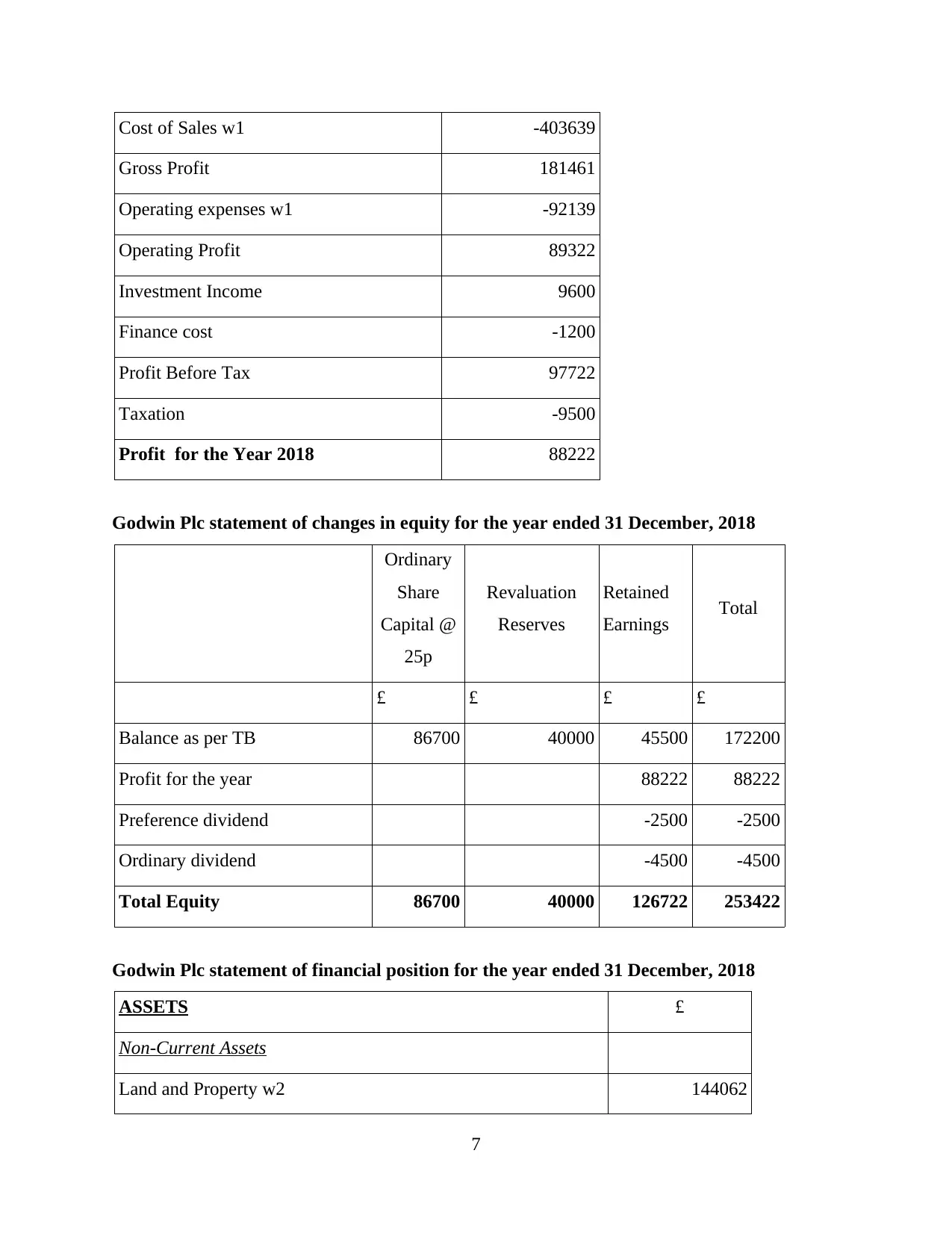
Cost of Sales w1 -403639
Gross Profit 181461
Operating expenses w1 -92139
Operating Profit 89322
Investment Income 9600
Finance cost -1200
Profit Before Tax 97722
Taxation -9500
Profit for the Year 2018 88222
Godwin Plc statement of changes in equity for the year ended 31 December, 2018
Ordinary
Share
Capital @
25p
Revaluation
Reserves
Retained
Earnings Total
£ £ £ £
Balance as per TB 86700 40000 45500 172200
Profit for the year 88222 88222
Preference dividend -2500 -2500
Ordinary dividend -4500 -4500
Total Equity 86700 40000 126722 253422
Godwin Plc statement of financial position for the year ended 31 December, 2018
ASSETS £
Non-Current Assets
Land and Property w2 144062
7
Gross Profit 181461
Operating expenses w1 -92139
Operating Profit 89322
Investment Income 9600
Finance cost -1200
Profit Before Tax 97722
Taxation -9500
Profit for the Year 2018 88222
Godwin Plc statement of changes in equity for the year ended 31 December, 2018
Ordinary
Share
Capital @
25p
Revaluation
Reserves
Retained
Earnings Total
£ £ £ £
Balance as per TB 86700 40000 45500 172200
Profit for the year 88222 88222
Preference dividend -2500 -2500
Ordinary dividend -4500 -4500
Total Equity 86700 40000 126722 253422
Godwin Plc statement of financial position for the year ended 31 December, 2018
ASSETS £
Non-Current Assets
Land and Property w2 144062
7
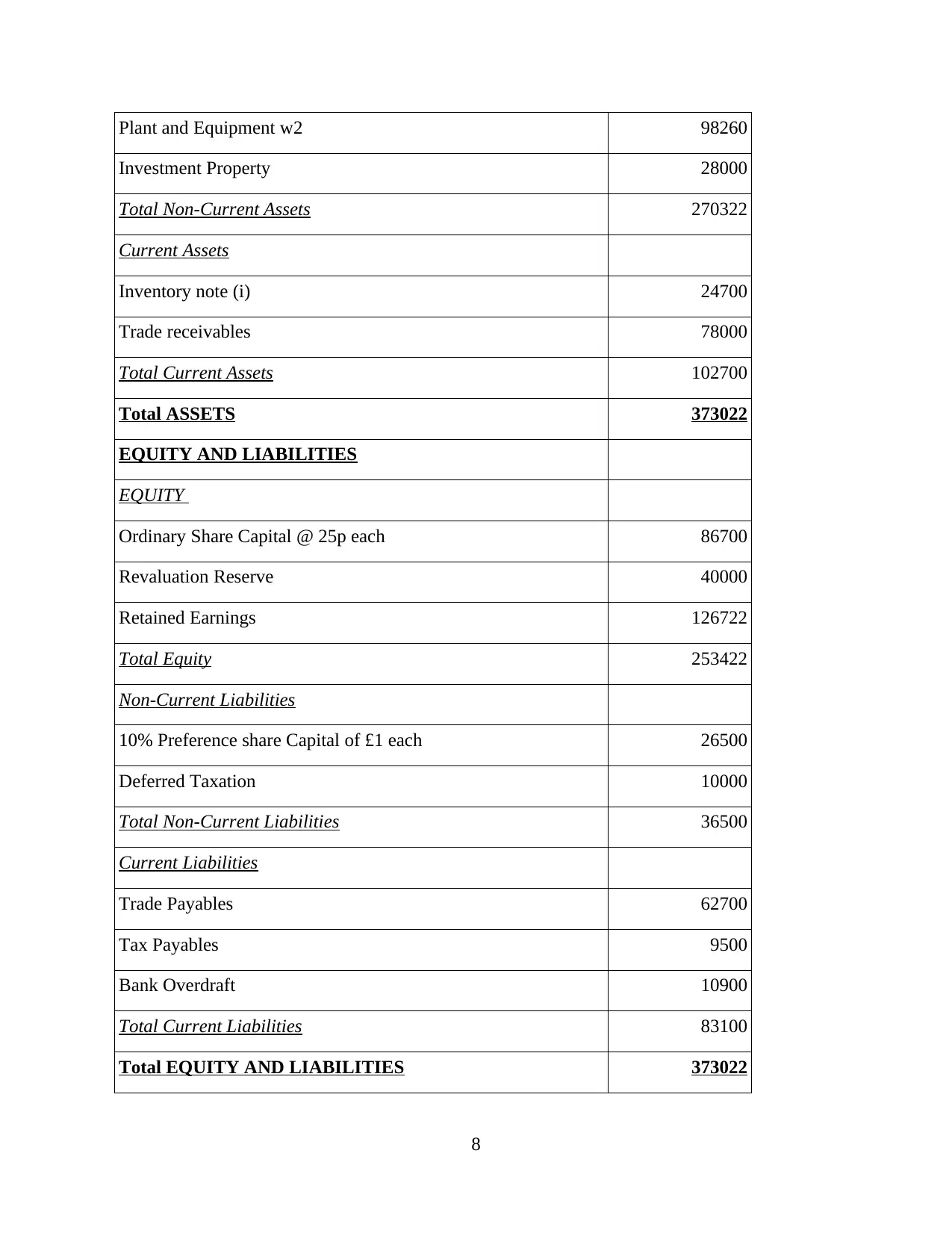
Plant and Equipment w2 98260
Investment Property 28000
Total Non-Current Assets 270322
Current Assets
Inventory note (i) 24700
Trade receivables 78000
Total Current Assets 102700
Total ASSETS 373022
EQUITY AND LIABILITIES
EQUITY
Ordinary Share Capital @ 25p each 86700
Revaluation Reserve 40000
Retained Earnings 126722
Total Equity 253422
Non-Current Liabilities
10% Preference share Capital of £1 each 26500
Deferred Taxation 10000
Total Non-Current Liabilities 36500
Current Liabilities
Trade Payables 62700
Tax Payables 9500
Bank Overdraft 10900
Total Current Liabilities 83100
Total EQUITY AND LIABILITIES 373022
8
Investment Property 28000
Total Non-Current Assets 270322
Current Assets
Inventory note (i) 24700
Trade receivables 78000
Total Current Assets 102700
Total ASSETS 373022
EQUITY AND LIABILITIES
EQUITY
Ordinary Share Capital @ 25p each 86700
Revaluation Reserve 40000
Retained Earnings 126722
Total Equity 253422
Non-Current Liabilities
10% Preference share Capital of £1 each 26500
Deferred Taxation 10000
Total Non-Current Liabilities 36500
Current Liabilities
Trade Payables 62700
Tax Payables 9500
Bank Overdraft 10900
Total Current Liabilities 83100
Total EQUITY AND LIABILITIES 373022
8
Secure Best Marks with AI Grader
Need help grading? Try our AI Grader for instant feedback on your assignments.
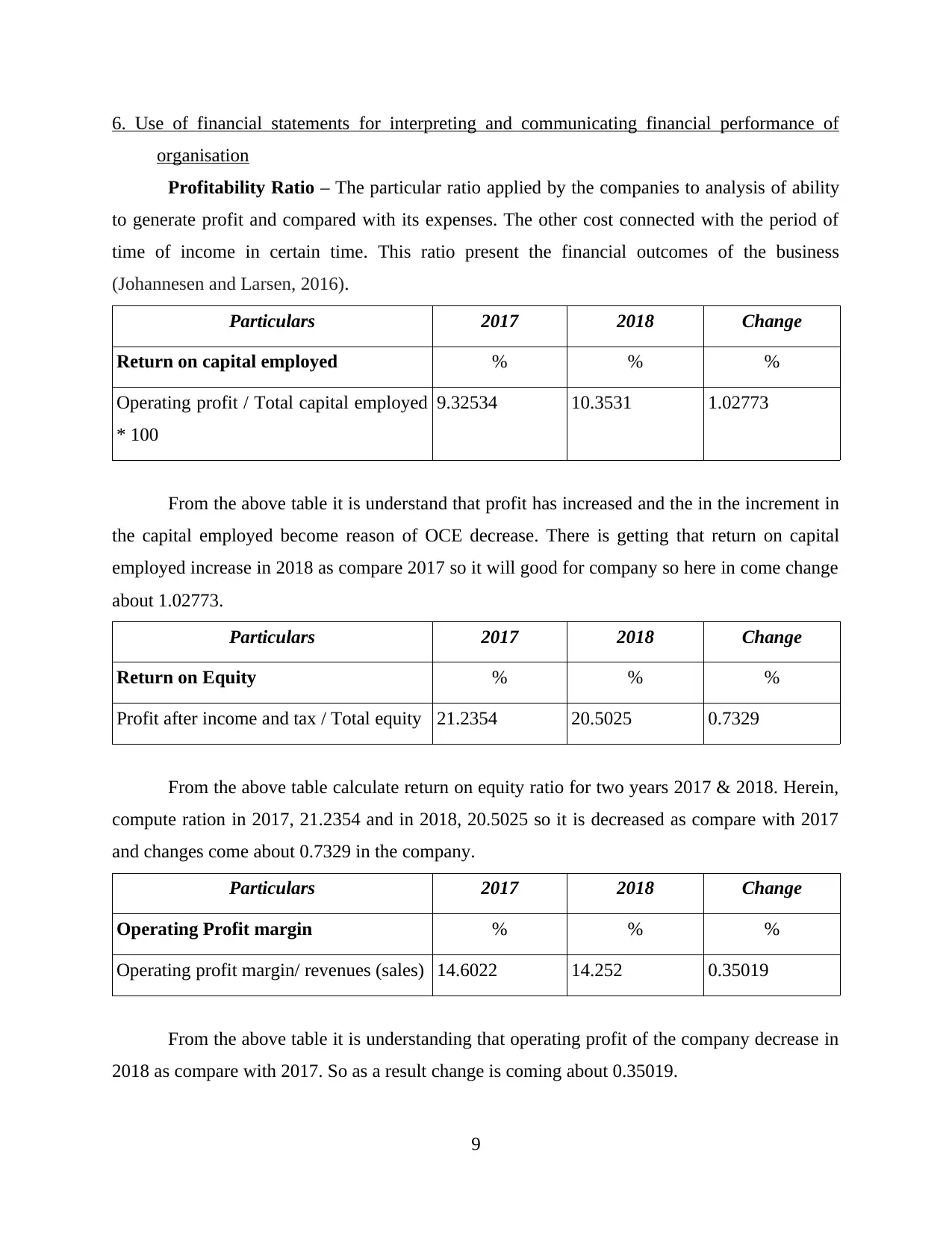
6. Use of financial statements for interpreting and communicating financial performance of
organisation
Profitability Ratio – The particular ratio applied by the companies to analysis of ability
to generate profit and compared with its expenses. The other cost connected with the period of
time of income in certain time. This ratio present the financial outcomes of the business
(Johannesen and Larsen, 2016).
Particulars 2017 2018 Change
Return on capital employed % % %
Operating profit / Total capital employed
* 100
9.32534 10.3531 1.02773
From the above table it is understand that profit has increased and the in the increment in
the capital employed become reason of OCE decrease. There is getting that return on capital
employed increase in 2018 as compare 2017 so it will good for company so here in come change
about 1.02773.
Particulars 2017 2018 Change
Return on Equity % % %
Profit after income and tax / Total equity 21.2354 20.5025 0.7329
From the above table calculate return on equity ratio for two years 2017 & 2018. Herein,
compute ration in 2017, 21.2354 and in 2018, 20.5025 so it is decreased as compare with 2017
and changes come about 0.7329 in the company.
Particulars 2017 2018 Change
Operating Profit margin % % %
Operating profit margin/ revenues (sales) 14.6022 14.252 0.35019
From the above table it is understanding that operating profit of the company decrease in
2018 as compare with 2017. So as a result change is coming about 0.35019.
9
organisation
Profitability Ratio – The particular ratio applied by the companies to analysis of ability
to generate profit and compared with its expenses. The other cost connected with the period of
time of income in certain time. This ratio present the financial outcomes of the business
(Johannesen and Larsen, 2016).
Particulars 2017 2018 Change
Return on capital employed % % %
Operating profit / Total capital employed
* 100
9.32534 10.3531 1.02773
From the above table it is understand that profit has increased and the in the increment in
the capital employed become reason of OCE decrease. There is getting that return on capital
employed increase in 2018 as compare 2017 so it will good for company so here in come change
about 1.02773.
Particulars 2017 2018 Change
Return on Equity % % %
Profit after income and tax / Total equity 21.2354 20.5025 0.7329
From the above table calculate return on equity ratio for two years 2017 & 2018. Herein,
compute ration in 2017, 21.2354 and in 2018, 20.5025 so it is decreased as compare with 2017
and changes come about 0.7329 in the company.
Particulars 2017 2018 Change
Operating Profit margin % % %
Operating profit margin/ revenues (sales) 14.6022 14.252 0.35019
From the above table it is understanding that operating profit of the company decrease in
2018 as compare with 2017. So as a result change is coming about 0.35019.
9
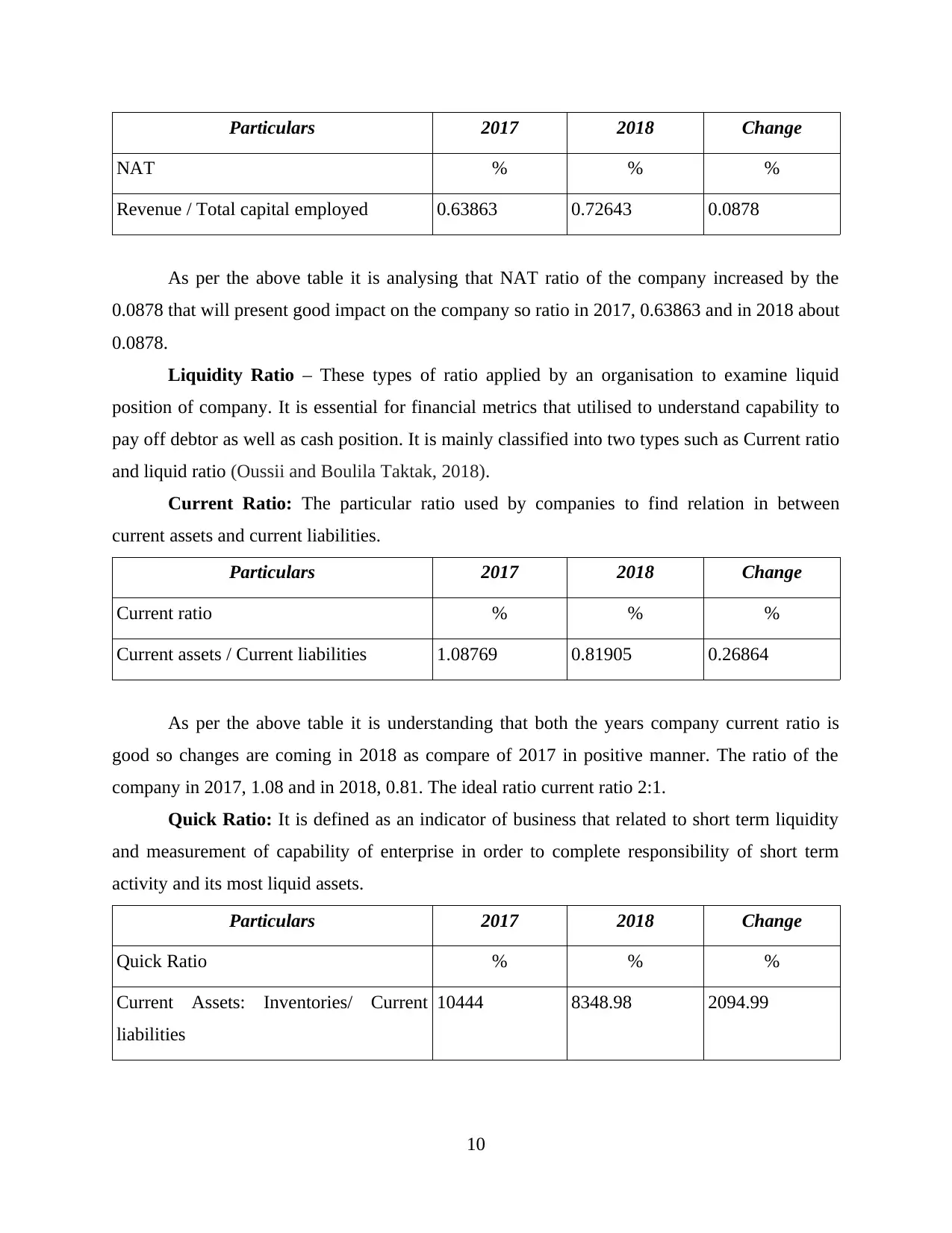
Particulars 2017 2018 Change
NAT % % %
Revenue / Total capital employed 0.63863 0.72643 0.0878
As per the above table it is analysing that NAT ratio of the company increased by the
0.0878 that will present good impact on the company so ratio in 2017, 0.63863 and in 2018 about
0.0878.
Liquidity Ratio – These types of ratio applied by an organisation to examine liquid
position of company. It is essential for financial metrics that utilised to understand capability to
pay off debtor as well as cash position. It is mainly classified into two types such as Current ratio
and liquid ratio (Oussii and Boulila Taktak, 2018).
Current Ratio: The particular ratio used by companies to find relation in between
current assets and current liabilities.
Particulars 2017 2018 Change
Current ratio % % %
Current assets / Current liabilities 1.08769 0.81905 0.26864
As per the above table it is understanding that both the years company current ratio is
good so changes are coming in 2018 as compare of 2017 in positive manner. The ratio of the
company in 2017, 1.08 and in 2018, 0.81. The ideal ratio current ratio 2:1.
Quick Ratio: It is defined as an indicator of business that related to short term liquidity
and measurement of capability of enterprise in order to complete responsibility of short term
activity and its most liquid assets.
Particulars 2017 2018 Change
Quick Ratio % % %
Current Assets: Inventories/ Current
liabilities
10444 8348.98 2094.99
10
NAT % % %
Revenue / Total capital employed 0.63863 0.72643 0.0878
As per the above table it is analysing that NAT ratio of the company increased by the
0.0878 that will present good impact on the company so ratio in 2017, 0.63863 and in 2018 about
0.0878.
Liquidity Ratio – These types of ratio applied by an organisation to examine liquid
position of company. It is essential for financial metrics that utilised to understand capability to
pay off debtor as well as cash position. It is mainly classified into two types such as Current ratio
and liquid ratio (Oussii and Boulila Taktak, 2018).
Current Ratio: The particular ratio used by companies to find relation in between
current assets and current liabilities.
Particulars 2017 2018 Change
Current ratio % % %
Current assets / Current liabilities 1.08769 0.81905 0.26864
As per the above table it is understanding that both the years company current ratio is
good so changes are coming in 2018 as compare of 2017 in positive manner. The ratio of the
company in 2017, 1.08 and in 2018, 0.81. The ideal ratio current ratio 2:1.
Quick Ratio: It is defined as an indicator of business that related to short term liquidity
and measurement of capability of enterprise in order to complete responsibility of short term
activity and its most liquid assets.
Particulars 2017 2018 Change
Quick Ratio % % %
Current Assets: Inventories/ Current
liabilities
10444 8348.98 2094.99
10
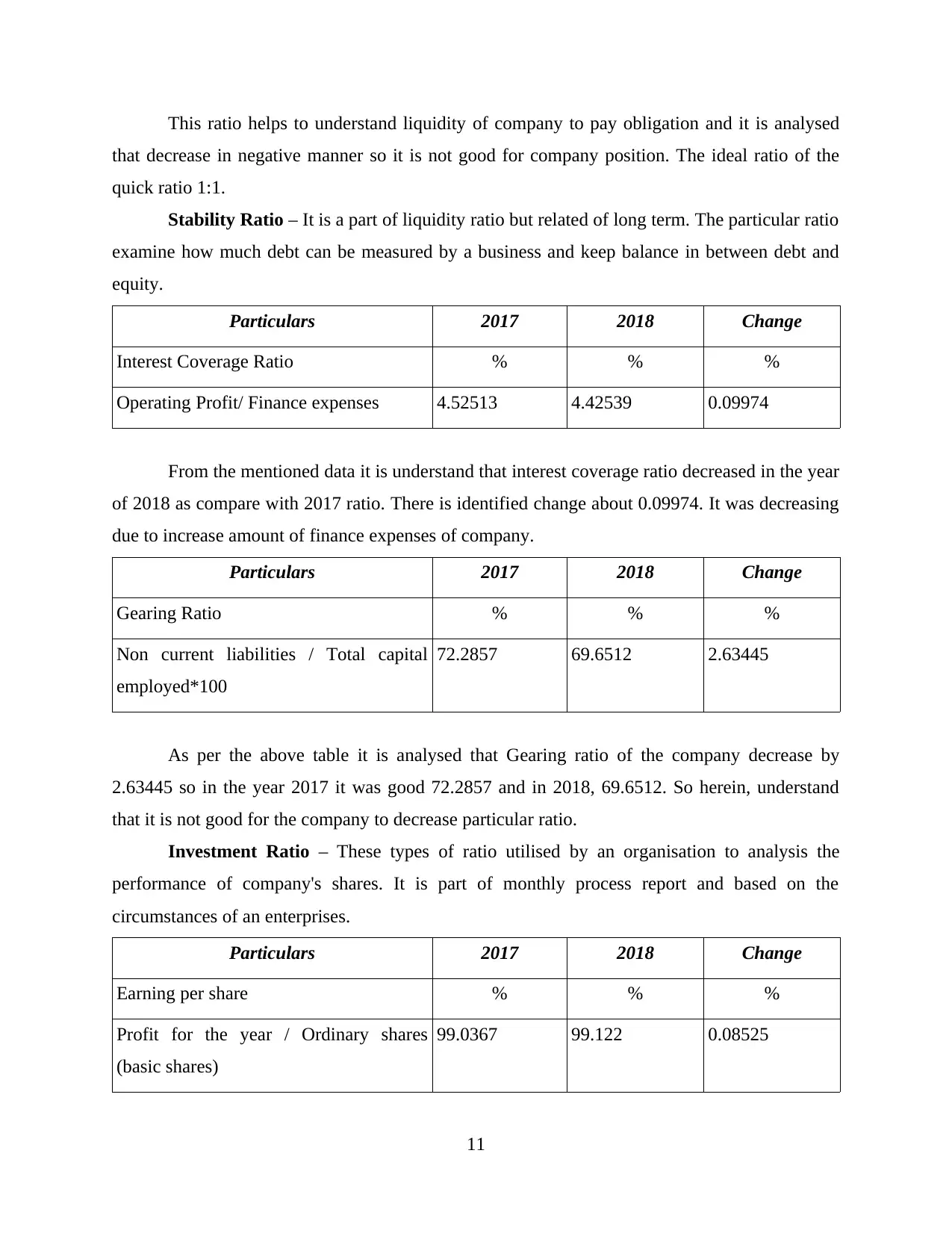
This ratio helps to understand liquidity of company to pay obligation and it is analysed
that decrease in negative manner so it is not good for company position. The ideal ratio of the
quick ratio 1:1.
Stability Ratio – It is a part of liquidity ratio but related of long term. The particular ratio
examine how much debt can be measured by a business and keep balance in between debt and
equity.
Particulars 2017 2018 Change
Interest Coverage Ratio % % %
Operating Profit/ Finance expenses 4.52513 4.42539 0.09974
From the mentioned data it is understand that interest coverage ratio decreased in the year
of 2018 as compare with 2017 ratio. There is identified change about 0.09974. It was decreasing
due to increase amount of finance expenses of company.
Particulars 2017 2018 Change
Gearing Ratio % % %
Non current liabilities / Total capital
employed*100
72.2857 69.6512 2.63445
As per the above table it is analysed that Gearing ratio of the company decrease by
2.63445 so in the year 2017 it was good 72.2857 and in 2018, 69.6512. So herein, understand
that it is not good for the company to decrease particular ratio.
Investment Ratio – These types of ratio utilised by an organisation to analysis the
performance of company's shares. It is part of monthly process report and based on the
circumstances of an enterprises.
Particulars 2017 2018 Change
Earning per share % % %
Profit for the year / Ordinary shares
(basic shares)
99.0367 99.122 0.08525
11
that decrease in negative manner so it is not good for company position. The ideal ratio of the
quick ratio 1:1.
Stability Ratio – It is a part of liquidity ratio but related of long term. The particular ratio
examine how much debt can be measured by a business and keep balance in between debt and
equity.
Particulars 2017 2018 Change
Interest Coverage Ratio % % %
Operating Profit/ Finance expenses 4.52513 4.42539 0.09974
From the mentioned data it is understand that interest coverage ratio decreased in the year
of 2018 as compare with 2017 ratio. There is identified change about 0.09974. It was decreasing
due to increase amount of finance expenses of company.
Particulars 2017 2018 Change
Gearing Ratio % % %
Non current liabilities / Total capital
employed*100
72.2857 69.6512 2.63445
As per the above table it is analysed that Gearing ratio of the company decrease by
2.63445 so in the year 2017 it was good 72.2857 and in 2018, 69.6512. So herein, understand
that it is not good for the company to decrease particular ratio.
Investment Ratio – These types of ratio utilised by an organisation to analysis the
performance of company's shares. It is part of monthly process report and based on the
circumstances of an enterprises.
Particulars 2017 2018 Change
Earning per share % % %
Profit for the year / Ordinary shares
(basic shares)
99.0367 99.122 0.08525
11
Paraphrase This Document
Need a fresh take? Get an instant paraphrase of this document with our AI Paraphraser
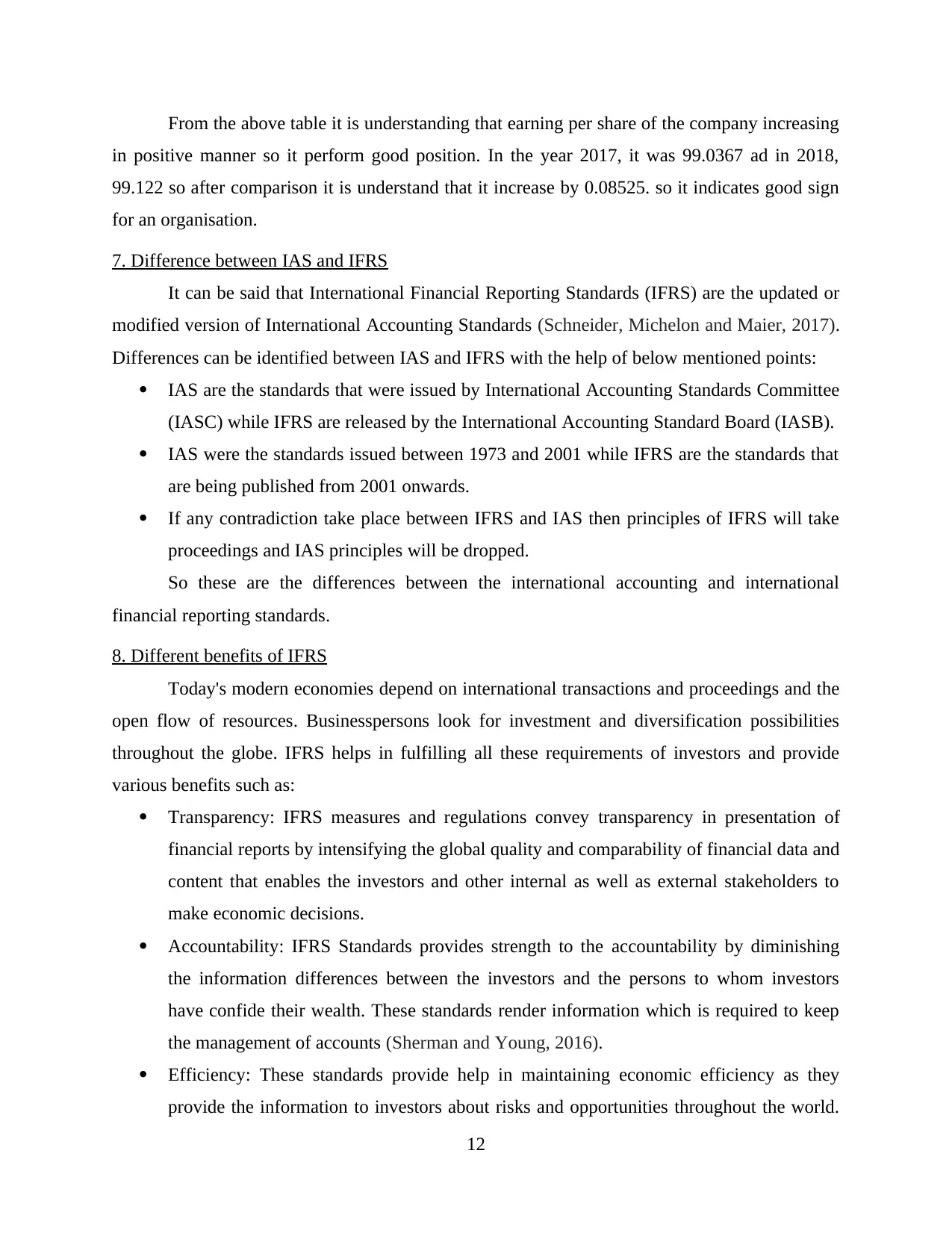
From the above table it is understanding that earning per share of the company increasing
in positive manner so it perform good position. In the year 2017, it was 99.0367 ad in 2018,
99.122 so after comparison it is understand that it increase by 0.08525. so it indicates good sign
for an organisation.
7. Difference between IAS and IFRS
It can be said that International Financial Reporting Standards (IFRS) are the updated or
modified version of International Accounting Standards (Schneider, Michelon and Maier, 2017).
Differences can be identified between IAS and IFRS with the help of below mentioned points:
IAS are the standards that were issued by International Accounting Standards Committee
(IASC) while IFRS are released by the International Accounting Standard Board (IASB).
IAS were the standards issued between 1973 and 2001 while IFRS are the standards that
are being published from 2001 onwards.
If any contradiction take place between IFRS and IAS then principles of IFRS will take
proceedings and IAS principles will be dropped.
So these are the differences between the international accounting and international
financial reporting standards.
8. Different benefits of IFRS
Today's modern economies depend on international transactions and proceedings and the
open flow of resources. Businesspersons look for investment and diversification possibilities
throughout the globe. IFRS helps in fulfilling all these requirements of investors and provide
various benefits such as:
Transparency: IFRS measures and regulations convey transparency in presentation of
financial reports by intensifying the global quality and comparability of financial data and
content that enables the investors and other internal as well as external stakeholders to
make economic decisions.
Accountability: IFRS Standards provides strength to the accountability by diminishing
the information differences between the investors and the persons to whom investors
have confide their wealth. These standards render information which is required to keep
the management of accounts (Sherman and Young, 2016).
Efficiency: These standards provide help in maintaining economic efficiency as they
provide the information to investors about risks and opportunities throughout the world.
12
in positive manner so it perform good position. In the year 2017, it was 99.0367 ad in 2018,
99.122 so after comparison it is understand that it increase by 0.08525. so it indicates good sign
for an organisation.
7. Difference between IAS and IFRS
It can be said that International Financial Reporting Standards (IFRS) are the updated or
modified version of International Accounting Standards (Schneider, Michelon and Maier, 2017).
Differences can be identified between IAS and IFRS with the help of below mentioned points:
IAS are the standards that were issued by International Accounting Standards Committee
(IASC) while IFRS are released by the International Accounting Standard Board (IASB).
IAS were the standards issued between 1973 and 2001 while IFRS are the standards that
are being published from 2001 onwards.
If any contradiction take place between IFRS and IAS then principles of IFRS will take
proceedings and IAS principles will be dropped.
So these are the differences between the international accounting and international
financial reporting standards.
8. Different benefits of IFRS
Today's modern economies depend on international transactions and proceedings and the
open flow of resources. Businesspersons look for investment and diversification possibilities
throughout the globe. IFRS helps in fulfilling all these requirements of investors and provide
various benefits such as:
Transparency: IFRS measures and regulations convey transparency in presentation of
financial reports by intensifying the global quality and comparability of financial data and
content that enables the investors and other internal as well as external stakeholders to
make economic decisions.
Accountability: IFRS Standards provides strength to the accountability by diminishing
the information differences between the investors and the persons to whom investors
have confide their wealth. These standards render information which is required to keep
the management of accounts (Sherman and Young, 2016).
Efficiency: These standards provide help in maintaining economic efficiency as they
provide the information to investors about risks and opportunities throughout the world.
12
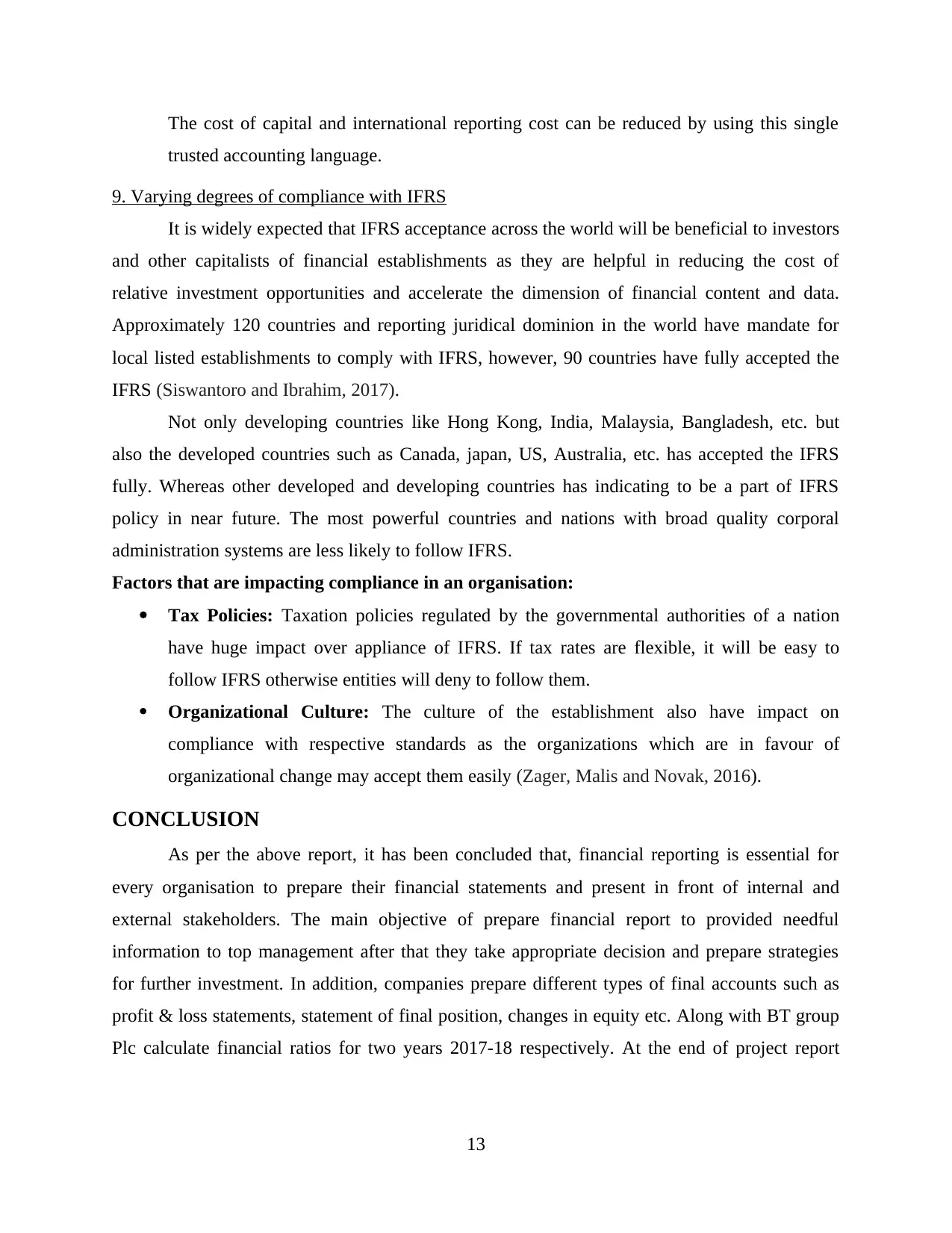
The cost of capital and international reporting cost can be reduced by using this single
trusted accounting language.
9. Varying degrees of compliance with IFRS
It is widely expected that IFRS acceptance across the world will be beneficial to investors
and other capitalists of financial establishments as they are helpful in reducing the cost of
relative investment opportunities and accelerate the dimension of financial content and data.
Approximately 120 countries and reporting juridical dominion in the world have mandate for
local listed establishments to comply with IFRS, however, 90 countries have fully accepted the
IFRS (Siswantoro and Ibrahim, 2017).
Not only developing countries like Hong Kong, India, Malaysia, Bangladesh, etc. but
also the developed countries such as Canada, japan, US, Australia, etc. has accepted the IFRS
fully. Whereas other developed and developing countries has indicating to be a part of IFRS
policy in near future. The most powerful countries and nations with broad quality corporal
administration systems are less likely to follow IFRS.
Factors that are impacting compliance in an organisation:
Tax Policies: Taxation policies regulated by the governmental authorities of a nation
have huge impact over appliance of IFRS. If tax rates are flexible, it will be easy to
follow IFRS otherwise entities will deny to follow them.
Organizational Culture: The culture of the establishment also have impact on
compliance with respective standards as the organizations which are in favour of
organizational change may accept them easily (Zager, Malis and Novak, 2016).
CONCLUSION
As per the above report, it has been concluded that, financial reporting is essential for
every organisation to prepare their financial statements and present in front of internal and
external stakeholders. The main objective of prepare financial report to provided needful
information to top management after that they take appropriate decision and prepare strategies
for further investment. In addition, companies prepare different types of final accounts such as
profit & loss statements, statement of final position, changes in equity etc. Along with BT group
Plc calculate financial ratios for two years 2017-18 respectively. At the end of project report
13
trusted accounting language.
9. Varying degrees of compliance with IFRS
It is widely expected that IFRS acceptance across the world will be beneficial to investors
and other capitalists of financial establishments as they are helpful in reducing the cost of
relative investment opportunities and accelerate the dimension of financial content and data.
Approximately 120 countries and reporting juridical dominion in the world have mandate for
local listed establishments to comply with IFRS, however, 90 countries have fully accepted the
IFRS (Siswantoro and Ibrahim, 2017).
Not only developing countries like Hong Kong, India, Malaysia, Bangladesh, etc. but
also the developed countries such as Canada, japan, US, Australia, etc. has accepted the IFRS
fully. Whereas other developed and developing countries has indicating to be a part of IFRS
policy in near future. The most powerful countries and nations with broad quality corporal
administration systems are less likely to follow IFRS.
Factors that are impacting compliance in an organisation:
Tax Policies: Taxation policies regulated by the governmental authorities of a nation
have huge impact over appliance of IFRS. If tax rates are flexible, it will be easy to
follow IFRS otherwise entities will deny to follow them.
Organizational Culture: The culture of the establishment also have impact on
compliance with respective standards as the organizations which are in favour of
organizational change may accept them easily (Zager, Malis and Novak, 2016).
CONCLUSION
As per the above report, it has been concluded that, financial reporting is essential for
every organisation to prepare their financial statements and present in front of internal and
external stakeholders. The main objective of prepare financial report to provided needful
information to top management after that they take appropriate decision and prepare strategies
for further investment. In addition, companies prepare different types of final accounts such as
profit & loss statements, statement of final position, changes in equity etc. Along with BT group
Plc calculate financial ratios for two years 2017-18 respectively. At the end of project report
13
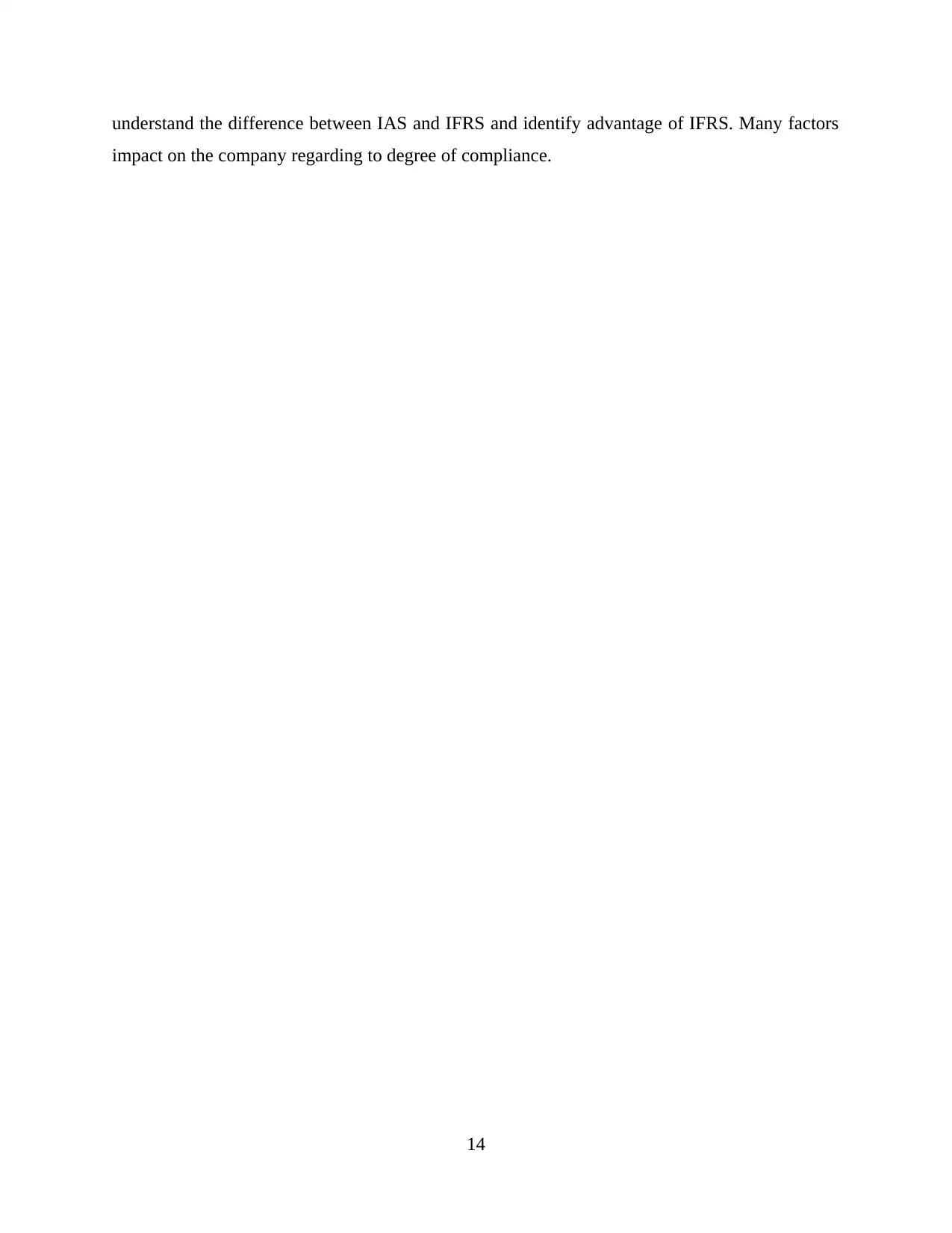
understand the difference between IAS and IFRS and identify advantage of IFRS. Many factors
impact on the company regarding to degree of compliance.
14
impact on the company regarding to degree of compliance.
14
Secure Best Marks with AI Grader
Need help grading? Try our AI Grader for instant feedback on your assignments.
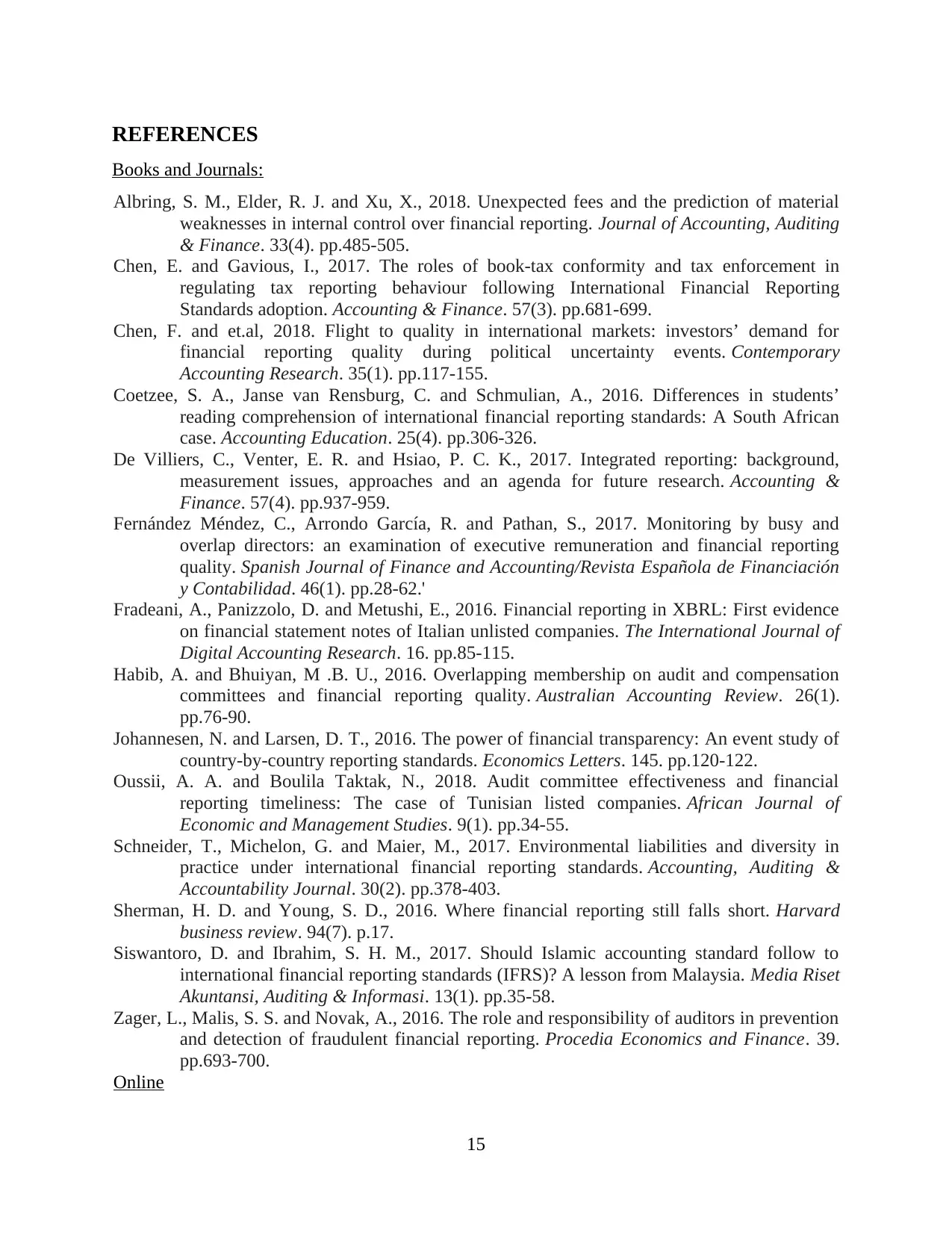
REFERENCES
Books and Journals:
Albring, S. M., Elder, R. J. and Xu, X., 2018. Unexpected fees and the prediction of material
weaknesses in internal control over financial reporting. Journal of Accounting, Auditing
& Finance. 33(4). pp.485-505.
Chen, E. and Gavious, I., 2017. The roles of book‐tax conformity and tax enforcement in
regulating tax reporting behaviour following International Financial Reporting
Standards adoption. Accounting & Finance. 57(3). pp.681-699.
Chen, F. and et.al, 2018. Flight to quality in international markets: investors’ demand for
financial reporting quality during political uncertainty events. Contemporary
Accounting Research. 35(1). pp.117-155.
Coetzee, S. A., Janse van Rensburg, C. and Schmulian, A., 2016. Differences in students’
reading comprehension of international financial reporting standards: A South African
case. Accounting Education. 25(4). pp.306-326.
De Villiers, C., Venter, E. R. and Hsiao, P. C. K., 2017. Integrated reporting: background,
measurement issues, approaches and an agenda for future research. Accounting &
Finance. 57(4). pp.937-959.
Fernández Méndez, C., Arrondo García, R. and Pathan, S., 2017. Monitoring by busy and
overlap directors: an examination of executive remuneration and financial reporting
quality. Spanish Journal of Finance and Accounting/Revista Española de Financiación
y Contabilidad. 46(1). pp.28-62.'
Fradeani, A., Panizzolo, D. and Metushi, E., 2016. Financial reporting in XBRL: First evidence
on financial statement notes of Italian unlisted companies. The International Journal of
Digital Accounting Research. 16. pp.85-115.
Habib, A. and Bhuiyan, M .B. U., 2016. Overlapping membership on audit and compensation
committees and financial reporting quality. Australian Accounting Review. 26(1).
pp.76-90.
Johannesen, N. and Larsen, D. T., 2016. The power of financial transparency: An event study of
country-by-country reporting standards. Economics Letters. 145. pp.120-122.
Oussii, A. A. and Boulila Taktak, N., 2018. Audit committee effectiveness and financial
reporting timeliness: The case of Tunisian listed companies. African Journal of
Economic and Management Studies. 9(1). pp.34-55.
Schneider, T., Michelon, G. and Maier, M., 2017. Environmental liabilities and diversity in
practice under international financial reporting standards. Accounting, Auditing &
Accountability Journal. 30(2). pp.378-403.
Sherman, H. D. and Young, S. D., 2016. Where financial reporting still falls short. Harvard
business review. 94(7). p.17.
Siswantoro, D. and Ibrahim, S. H. M., 2017. Should Islamic accounting standard follow to
international financial reporting standards (IFRS)? A lesson from Malaysia. Media Riset
Akuntansi, Auditing & Informasi. 13(1). pp.35-58.
Zager, L., Malis, S. S. and Novak, A., 2016. The role and responsibility of auditors in prevention
and detection of fraudulent financial reporting. Procedia Economics and Finance. 39.
pp.693-700.
Online
15
Books and Journals:
Albring, S. M., Elder, R. J. and Xu, X., 2018. Unexpected fees and the prediction of material
weaknesses in internal control over financial reporting. Journal of Accounting, Auditing
& Finance. 33(4). pp.485-505.
Chen, E. and Gavious, I., 2017. The roles of book‐tax conformity and tax enforcement in
regulating tax reporting behaviour following International Financial Reporting
Standards adoption. Accounting & Finance. 57(3). pp.681-699.
Chen, F. and et.al, 2018. Flight to quality in international markets: investors’ demand for
financial reporting quality during political uncertainty events. Contemporary
Accounting Research. 35(1). pp.117-155.
Coetzee, S. A., Janse van Rensburg, C. and Schmulian, A., 2016. Differences in students’
reading comprehension of international financial reporting standards: A South African
case. Accounting Education. 25(4). pp.306-326.
De Villiers, C., Venter, E. R. and Hsiao, P. C. K., 2017. Integrated reporting: background,
measurement issues, approaches and an agenda for future research. Accounting &
Finance. 57(4). pp.937-959.
Fernández Méndez, C., Arrondo García, R. and Pathan, S., 2017. Monitoring by busy and
overlap directors: an examination of executive remuneration and financial reporting
quality. Spanish Journal of Finance and Accounting/Revista Española de Financiación
y Contabilidad. 46(1). pp.28-62.'
Fradeani, A., Panizzolo, D. and Metushi, E., 2016. Financial reporting in XBRL: First evidence
on financial statement notes of Italian unlisted companies. The International Journal of
Digital Accounting Research. 16. pp.85-115.
Habib, A. and Bhuiyan, M .B. U., 2016. Overlapping membership on audit and compensation
committees and financial reporting quality. Australian Accounting Review. 26(1).
pp.76-90.
Johannesen, N. and Larsen, D. T., 2016. The power of financial transparency: An event study of
country-by-country reporting standards. Economics Letters. 145. pp.120-122.
Oussii, A. A. and Boulila Taktak, N., 2018. Audit committee effectiveness and financial
reporting timeliness: The case of Tunisian listed companies. African Journal of
Economic and Management Studies. 9(1). pp.34-55.
Schneider, T., Michelon, G. and Maier, M., 2017. Environmental liabilities and diversity in
practice under international financial reporting standards. Accounting, Auditing &
Accountability Journal. 30(2). pp.378-403.
Sherman, H. D. and Young, S. D., 2016. Where financial reporting still falls short. Harvard
business review. 94(7). p.17.
Siswantoro, D. and Ibrahim, S. H. M., 2017. Should Islamic accounting standard follow to
international financial reporting standards (IFRS)? A lesson from Malaysia. Media Riset
Akuntansi, Auditing & Informasi. 13(1). pp.35-58.
Zager, L., Malis, S. S. and Novak, A., 2016. The role and responsibility of auditors in prevention
and detection of fraudulent financial reporting. Procedia Economics and Finance. 39.
pp.693-700.
Online
15
1 out of 17
Related Documents
Your All-in-One AI-Powered Toolkit for Academic Success.
+13062052269
info@desklib.com
Available 24*7 on WhatsApp / Email
![[object Object]](/_next/static/media/star-bottom.7253800d.svg)
Unlock your academic potential
© 2024 | Zucol Services PVT LTD | All rights reserved.





